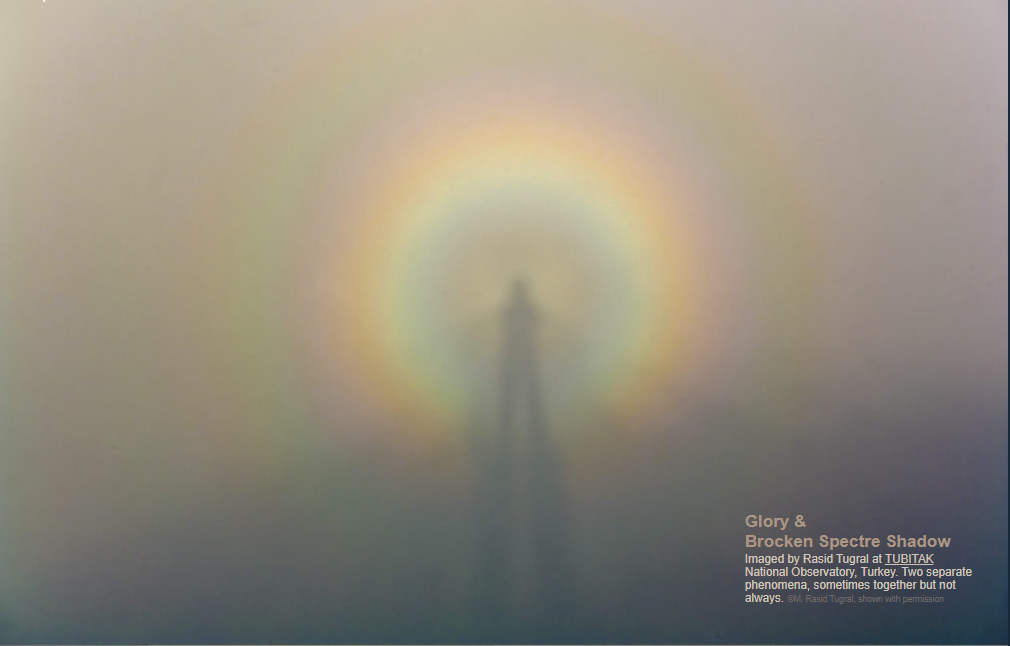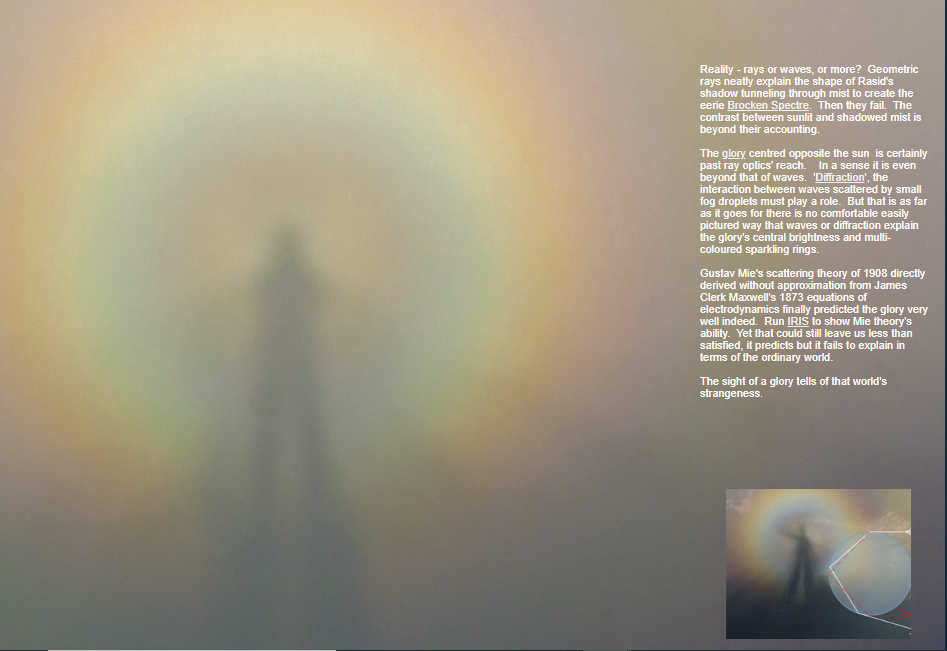OPOD - Glory & Brocken Spectre
OPOD - Glory & Brocken Spectre: A Fascinating Phenomenon Revealed
Have you ever witnessed the mesmerizing beauty of a glory or the eerie shadow of a Brocken Spectre? These atmospheric optics phenomena are truly captivating, and in this article, we will delve deeper into their intriguing nature. While they can sometimes occur together, they are distinct phenomena with their own unique characteristics.
Let's start with the Brocken Spectre. When observed, it appears as a shadowy figure surrounded by a halo of light. The figure is often seen on misty mountainsides or clouds, and it is caused by the interaction of sunlight with water droplets in the air. The geometric rays of light can neatly explain the shape of the shadow tunneling through the mist, creating this ethereal spectacle. However, there is more to it than just rays or waves.
The contrast between the sunlit and shadowed mist goes beyond the explanation provided by geometric rays. This is where the phenomenon becomes even more perplexing. While diffraction, the interaction between waves scattered by small fog droplets, plays a role in the formation of the Brocken Spectre, it fails to fully account for the glory's central brightness and multi-colored sparkling rings.
To understand the glory, we turn to Gustav Mie's scattering theory of 1908, which was derived directly from James Clerk Maxwell's equations of electrodynamics. Mie's theory successfully predicts the glory, as demonstrated by the results obtained from running IRIS simulations. However, even with this accurate prediction, we are left with a sense of curiosity as Mie's theory does not provide a clear explanation within the framework of our ordinary world.
The glory, with its central brightness and shimmering rings, continues to intrigue us and reminds us of the strangeness that can be found in our everyday surroundings. Its existence serves as a testament to the complex interactions between light and matter in our atmosphere.
In summary, the glory and Brocken Spectre are atmospheric optics phenomena that have fascinated scientists and observers alike. While geometric rays and diffraction can partially explain the formation of the Brocken Spectre, the glory remains a mysterious phenomenon that defies easy explanation. Mie's scattering theory offers a predictive framework for the glory, but it leaves us with a yearning to understand its underlying mechanisms in terms of our familiar world.
Next time you find yourself in the presence of a glory or witness the shadowy figure of a Brocken Spectre, take a moment to appreciate the wonders of our atmosphere and the intricacies of light. These phenomena serve as a reminder of the boundless beauty and complexity that can be found right above our heads.

Glory &
Brocken Spectre Shadow
Imaged by Rasid Tugral at TUBITAK
National Observatory, Turkey. Two separate phenomena, sometimes together but not always. ©M. Rasid Tugral, shown with permission

Reality - rays or waves, or more? Geometric rays neatly explain the shape of Rasid's shadow tunneling through mist to create the eerie Brocken Spectre. Then they fail. The contrast between sunlit and shadowed mist is beyond their accounting.
The glory centred opposite the sun is certainly past ray optics' reach. In a sense it is even beyond that of waves. 'Diffraction', the interaction between waves scattered by small fog droplets must play a role. But that is as far as it goes for there is no comfortable easily pictured way that waves or diffraction explain the glory's central brightness and multi-coloured sparkling rings.
Gustav Mie's scattering theory of 1908 directly derived without approximation from James Clerk Maxwell's 1873 equations of electrodynamics finally predicted the glory very well indeed. Run IRIS to show Mie theory's ability. Yet that could still leave us less than satisfied, it predicts but it fails to explain in terms of the ordinary world.
The sight of a glory tells of that world's strangeness.
Note: this article has been automatically converted from the old site and may not appear as intended. You can find the original article here.
Reference Atmospheric Optics
If you use any of the definitions, information, or data presented on Atmospheric Optics, please copy the link or reference below to properly credit us as the reference source. Thank you!
-
<a href="https://atoptics.co.uk/blog/opod-glory-brocken-spectre/">OPOD - Glory & Brocken Spectre</a>
-
"OPOD - Glory & Brocken Spectre". Atmospheric Optics. Accessed on November 26, 2024. https://atoptics.co.uk/blog/opod-glory-brocken-spectre/.
-
"OPOD - Glory & Brocken Spectre". Atmospheric Optics, https://atoptics.co.uk/blog/opod-glory-brocken-spectre/. Accessed 26 November, 2024
-
OPOD - Glory & Brocken Spectre. Atmospheric Optics. Retrieved from https://atoptics.co.uk/blog/opod-glory-brocken-spectre/.